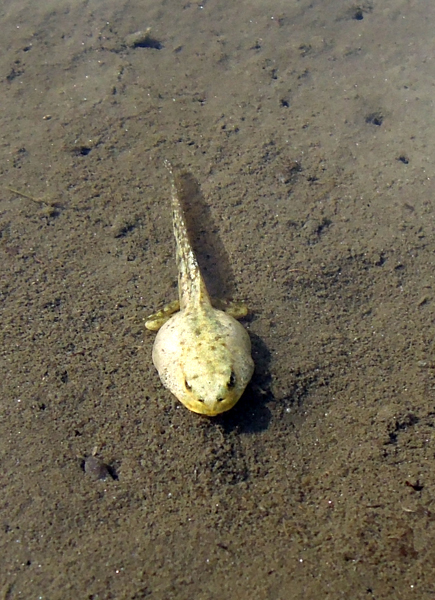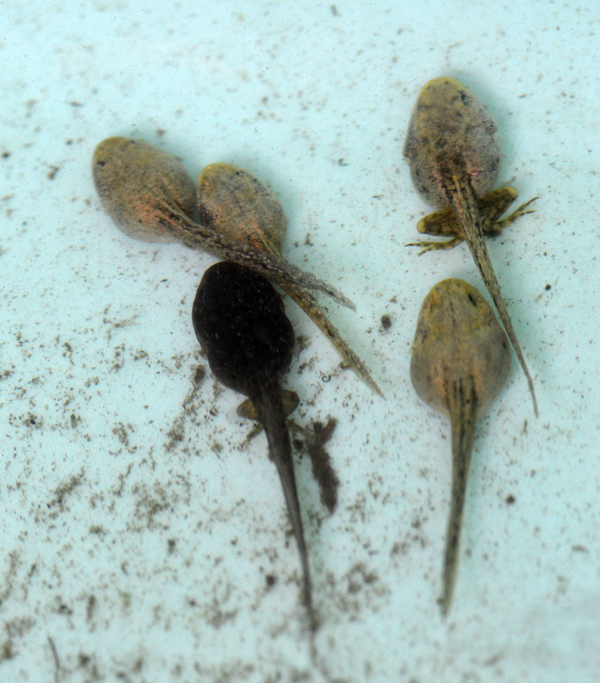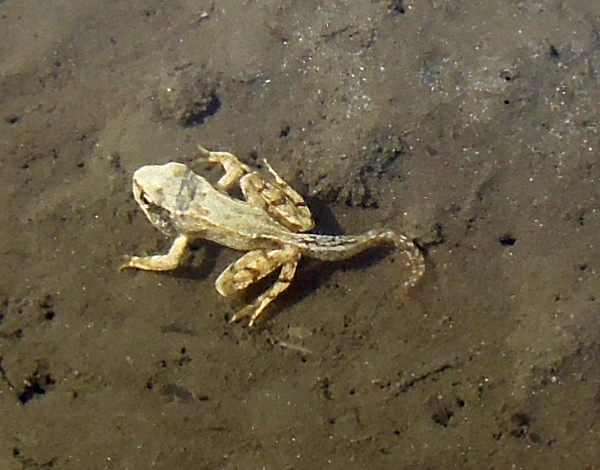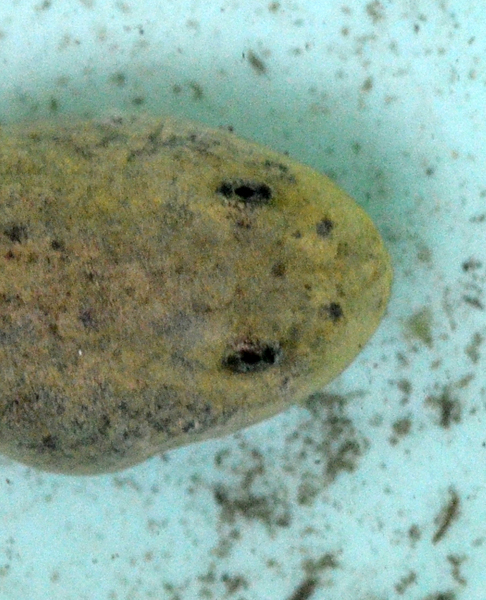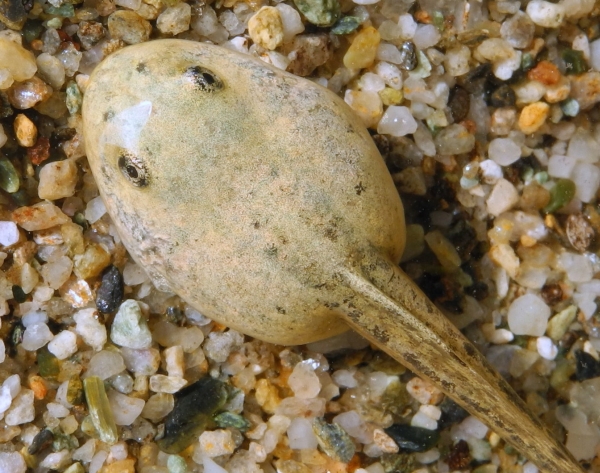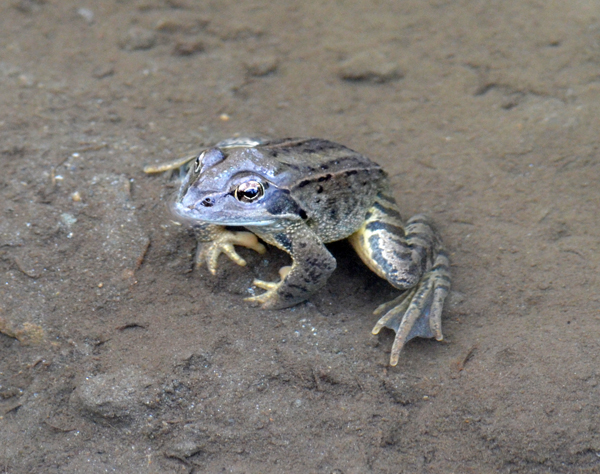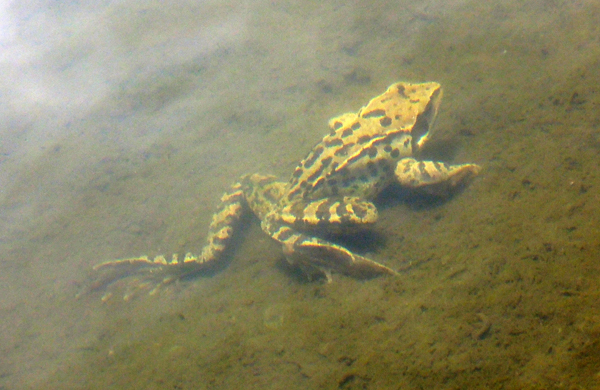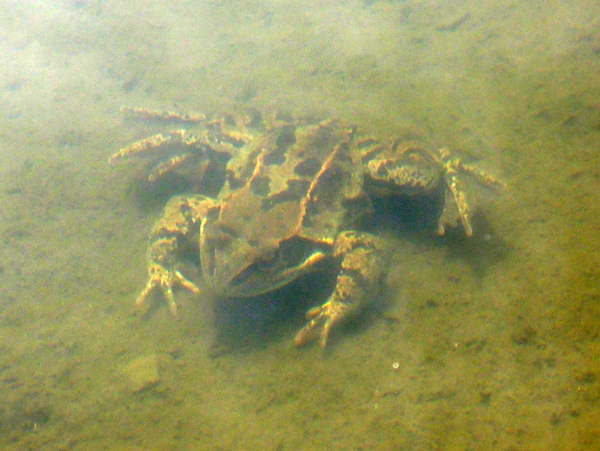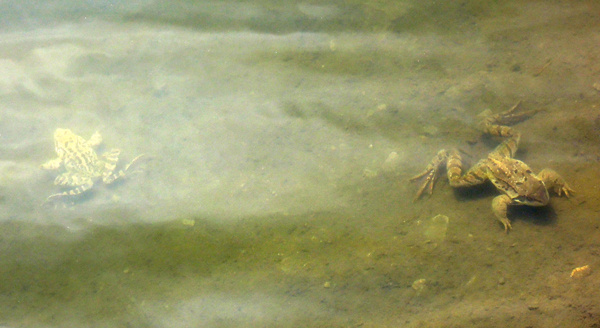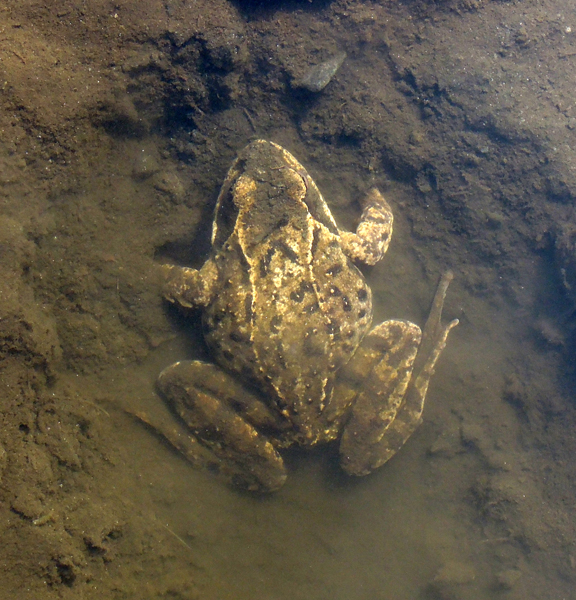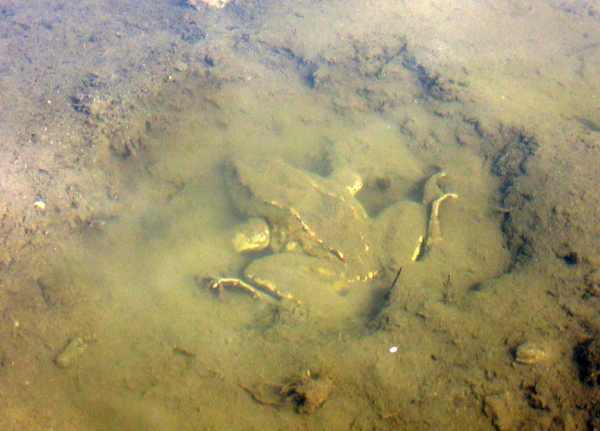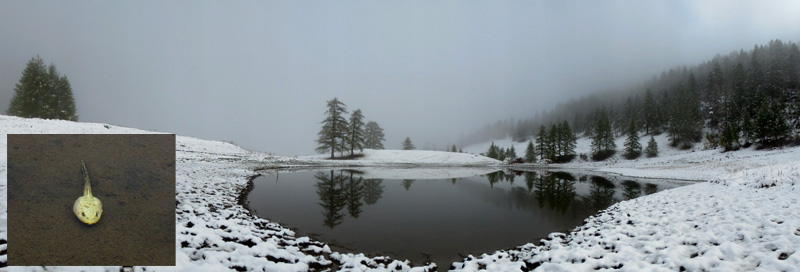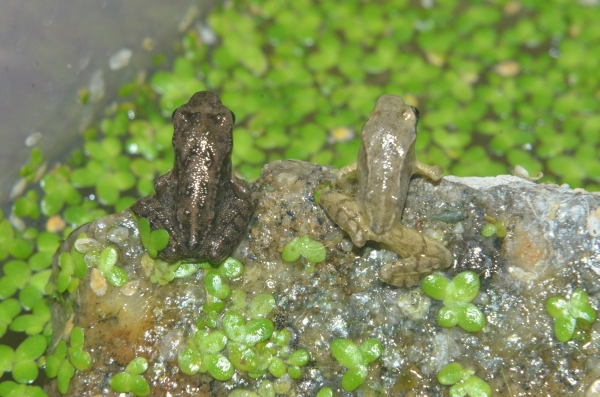
Spetember 2013. Two captive individuals just metamorphosed.
The normal one on the left; the white one showing the missing eye on
the right.
One picture does not have statistical relevance but shows that the
white one is even less visible than the ordinary one.
It is important to highlight that the animals, in this case the
predators, do not see as humans do and that Rana temporaria spends more
time in the grass than in the water. It is necessary to make further
studies but the first look is like that.
As amphibians, within limits, adapt their skin colour to the
background, on suggestion of an herpetologist I covered the
normal sand of my aquarium with 100% black artificial aquarium sand.
Four weeks after the sand addition no relevant colour changes were
visible.
My feeling was that some darkening actually happened, but within limits
that I was not able to document. This could be logic if the white
specimen kept the adoption capability although based on a different
starting point.
The experiment took place in January/February 2014. In this season
tadpoles usually don't exist at all. I cannot separate the effect of
the background form the one of the abnormal season.
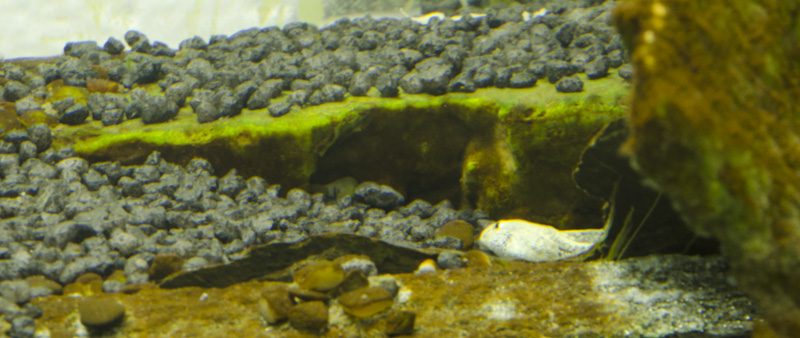
February 2014. White tadpole some weeks after the black sand was used
to darked the background.
Some hypothesis to
work on.
The color of the Rana temporaria, as any other characteristic of any
live specimen, went through a natural selection that promoted the ones
that helped individuals to reproduce most.
Mating, by its very nature, produces always-different individuals with
the only exceptions of monozygotic twins. It is statistically almost
impossible that two individuals carry identical genome.
Only survivors were able to transfer their genes to the future.
A new advantageous characteristic generated by a random genetic
accident, takes a relatively short time to spread into the all
population; geologically speaking… But in terms of human life it takes
a very long time.
In this case something has happened quite quickly. Probably less than a
decade as the lake used to be dried earlier… What could have triggered
this?
The correct answer is “I don’t know”.
However, as I have been working until this point, let me go on with
more hypothesis.
I have no means to forecast if it will be correct on not; not if it
will be just a loss of time. By sure I dedicate it to Charles Darwin.
With almost no scientific tools besides a block notes and a pen, he was
able to understand the very essence of how life works and allowed to
understand anything happen in the life on hearth.
The fact that white individuals are so common means that that color –
at least – is not a major disadvantage. I mean that if it made the
animal more visible to predators, they would disappear.
These options can be imagined:
There is an ongoing selection mechanism that promotes the color for
some reason
The selection factor that used to keep the color away is not working
which trigger the so-called “de-selection” of the genes that operate in
that area.
The Bó dâ Col lake – in natural condition – is a closed lake. Water
comes from a spring a few meter away from the lake rising form a
calcareous rock.
Most of the year the water only evaporates or is absorbed by the
ground, as there is not a visible permanent emissary. The water should
be very transparent and clean as it normally is in mountain lakes.
In this case, the lake is in the center of a large cattle farm and
widely used form caws as drinking water; but the consequence is that a
significant amount of excrements drops into the water.
Therefore, one hypothesis can be that the modified chemical, physical
and biological characteristics of the water generate a new situation,
which is favorable to the diffusion of the color feature.
The kind of reproductive cycle of the frog, combined with the high
number of individuals generated each year by each couple could help the
quick diffusion of the characteristic, which normally needs longer time.
What triggers this effect? Hard to say… But an option could be that the
human activities generate a slight color change in the lake which makes
more visible to predators the “normal” individuals, thus promoting the
others.
With those observations and hypothesis as a background, I made some
Internet research.
The “white” individuals are like this because of the lack of melatonin
(it is obvious but it is the starting point).
They also show, to a certain extent, neotenism. I.e. a portion of them
can hardly complete the metamorphosis or they do very late.
Some damages to the epiphysis can trigger both these problems.
The epiphysis suffers damages if the water shows high concentration of
fluorine, phosphorus and calcium.
The spring that supplies water to the lake is in a calcareous are
(otherwise rare in the valley) so there may be a high concentration of
calcium.
The massive presence of caws may increase the concentration of
phosphorus and fluorine.
If this was confirmed, it could be that the special chemical
characteristics of the water trigger the change. As this would happen
on a large scale and on a population subject to an extremely high
natural mortality, it could be that the inconveniences do not show up
as they disappear in the natural casualties allowing the survival of a
certain number of individuals.
None of this gives explanation about the missing eyes. One hypothesis
for which I am grateful to Daniele is that they are damaged during
attack of the dragonfly larvae, which could see the black eyes better
on a white background. We need the next season to make more
observations.
I go on.
Feel free to contact me on this subject on my
mail.
PS.
In this area, there is an urban legend that states that radioactivity
is tremendously high due to the leaks form the neighboring French
nuclear power station stating that “they” get rid of nuclear waste in
the environment as then it comes all by “us”.
To prevent idiot hypothesis I travelled around in the valley with a
Geiger. The value almost everywhere is about 0,2 μSievert which is the
natural background.
At the bottom of small channels where debris tend to deposit sometimes,
a minimum increase can be detected. In no case, the display shown
number worth reading…

Measurement made on the side of the lake on September 29
th,
2013: 0,196 μSievert.
2014
What happened to the captive individuals born in 2013?
In August 2014, when wild tadpoles were beginning to
metamorphose, the individuals from 2013 spawning were still in my
aquarium. Some died. The ones still alive look healthy.
Death normally happen after the individual has slimmed very badly. It
looks they cannot feed anymore.
Over summer, one year old individuals begun to show small back legs
which never grew over 2 to 4 mm.
Starting in February 2014, when the lake was still 100% frozen, I
followed closely what was going on.
With the arrival of spring and milder temperatures the ice begun to
melt. Then adults laid the eggs and spawning happened. During mating
hundreds of adults were present. Their colours ranged between brown and
grey as usual.
With newly born tadpoles, I could not see any white specimen. Of
course, checking the all population was impossible. However, if a
number of white individuals were present amongst the mass of black
ones, I assume they would have been very visible.
When they were big enough to be able to see with bare eye if they had
both eyes or not, I sampled some hundreds over 3 weeks and detected no
visible problems.
I could not visit the site over July 2014.
On August 10, 2014, I visited again the lake. Metamorphosis was going
on. Tadpoles are very large and many small frogs are already jumping in
the grass surrounding the lake.
I made 2 full tours of the lake at different times in the afternoon.
On the first tour I saw 4 white individuals of which 3 sure and one
very quickly.
On the second tour, I saw 6.
From that day onwards, I visited the lake until winter. Each time I
found white specimen. Apparently, the phenomenon was substantially the
same as the preceding year.
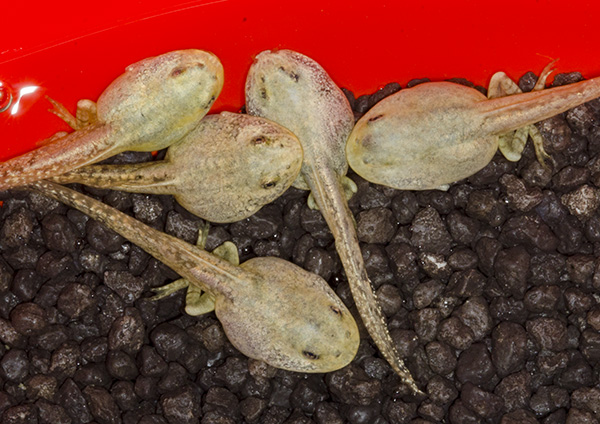
September 14, 2014. White individuals. Top left: asymmetrical eyes. Top
centre: undersized symmetrical eyes. Top right: one eye.
Resume of the observed effect of the unknown problem:
- alters the skin colour
- makes the individuals neotenic
- creates “one eyed” individuals and/or eye size modifications.
- generates some risk to have 3 legs only
I found all combinations of disease but I was missing the black
one-eyed neotenic individuals.
I have been looking for them over the summer with no results. I thought
it could have been a visibility issue. Spotting a one-eyed individual
amongst tens of thousands of normal one is just impossible. I developed
another idea: if it exists, most likely it should be also neotenic.
Therefore, I could more easily spot them after most individuals already
metamorphosed.
In autumn, when all normal individuals had disappeared already, some
tadpoles were still swimming and shown no legs. Two of them were black.
One of those had one eye!
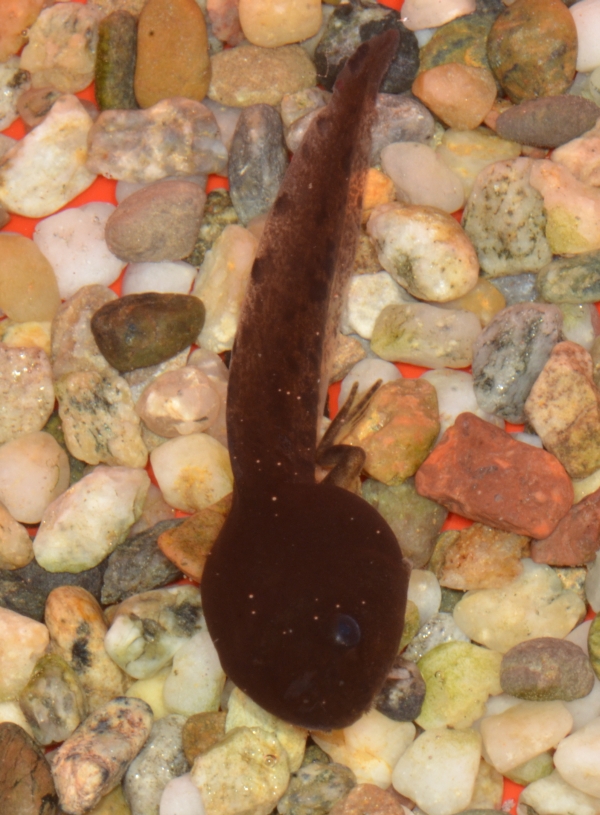
September 28, 2014. One eyed, black, neotenic individual.
The “white tadpoles” phenomenon happened already 2 years under my eyes.
The numbers are large enough that good observation can be made at any
time and any day.
It seems that all individuals hatch black. Whitening happens sometimes
in July.
During mating, I could not observe abnormal specimen. I was there only
one day. I assume mating lasted at least some days.
I wander if there could be a non-genetic reason for all of that. The
problem arises during summer. There could be an issue that develops its
effects over time. Fungi? Anything else?
Last minute remark.
At the end of the summer season, I noticed also some “white” specimen
of insects swimming in the water.
There is a relevant number of them. I moved some in my aquarium to
observe them. They seem normal individuals almost completely white.
At the moment I don’t know it this is a normal colour or not.
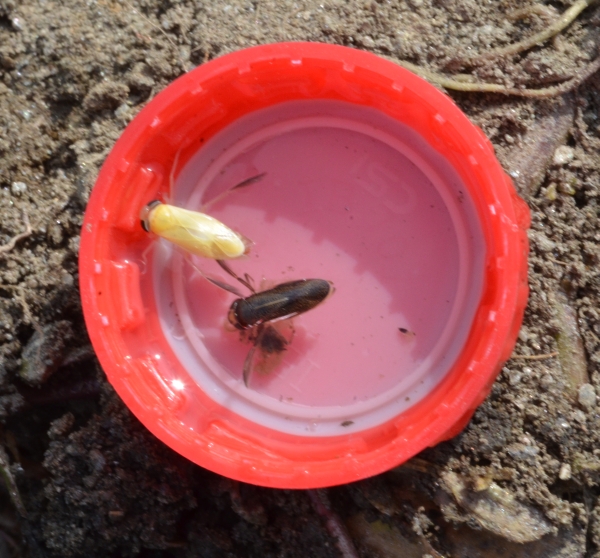
July 28, 2014. Two individuals of different colour.
2015
The extremely warm summer shortened a lot the breeding cycle. Combined
with limited time from my side, I was not able to make effective
observations.
I spotted only one white individual when no other tadpoles were around
any more but I was to ale to take a picture.
2016
Same situation as preceding year but I saw no white specimen. Short
breeding season and limited time make the remarks of little relevance.


